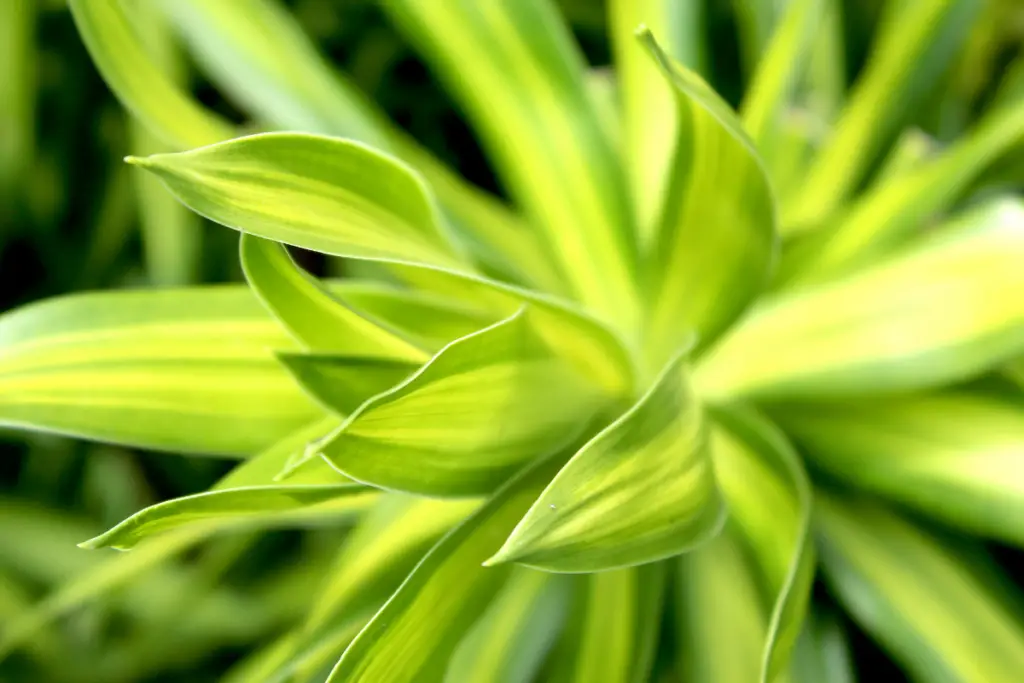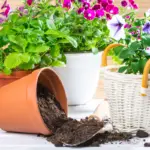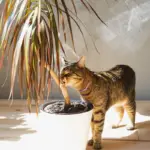Dracaena plants are a popular choice for indoor gardeners due to their attractive foliage and low maintenance requirements.
One of the best ways to propagate Dracaena plants is through stem cuttings.
Stem cuttings are a common method of plant propagation that can produce multiple plant clones at one time.
To propagate a Dracaena plant through stem cuttings, gardeners should first select a healthy plant and use sharp, clean tools to take a cutting.
The cutting should include at least one node, which is a round, white bump on the stem where roots can grow. Once the cutting has been taken, it can be rooted in water or soil.
Rooting hormone can also be used to promote faster growth and more new growth after propagation in soil.
Whether you are an experienced gardener or a beginner, propagating Dracaena plants can be a fun and rewarding experience.
With the right tools and techniques, you can easily produce multiple plant clones and enjoy the beauty of these popular indoor plants in every corner of your home.

Table of Contents
Understanding Dracaena Plants
Dracaena plants are popular houseplants known for their hardiness and ease of care. They are native to Africa and are available in a variety of shapes and sizes, making them a versatile choice for indoor greenery.
Dracaena plants are characterized by their long, sword-shaped leaves that can range in color from green to variegated.
They can grow up to 10 feet tall, but most varieties will stay smaller when grown in containers.
One of the reasons why dracaena plants are so popular is because they are relatively low-maintenance.
They can tolerate a range of light conditions, from low to bright, but prefer indirect sunlight. They also do well in average room temperatures and don’t require frequent watering.
However, it’s important to note that dracaena plants are toxic to pets, so they should be kept out of reach of cats and dogs.
Overall, dracaena plants are a great choice for those who want to add some greenery to their indoor spaces without a lot of fuss.
With proper care, these plants can thrive for years and add a touch of natural beauty to any room.
Importance of Propagation
Propagation is an essential aspect of plant care that allows gardeners to create new plants from existing ones.
Dracaena plants are no exception, and propagating them is an excellent way to expand your collection or share your plants with friends and family.
One of the main benefits of propagating Dracaena plants is that it helps to maintain the plant’s genetic diversity.
Over time, plants can become susceptible to disease or pests, which can weaken their overall health.
By propagating your Dracaena plants, you can create new plants that are genetically diverse and less susceptible to these issues.
Another advantage of propagating Dracaena plants is that it allows you to control the growth and shape of your plants.
By taking cuttings from your plants and propagating them, you can create new plants that are smaller or larger than the original plant.
This can be especially useful if you have limited space or want to create a specific look in your home or garden.
Propagation is also an excellent way to rejuvenate older plants. As Dracaena plants age, they can become leggy and lose their shape.
By taking cuttings and propagating them, you can create new plants that are more compact and bushy, making them more aesthetically pleasing.
Overall, propagation is an essential aspect of plant care that can help you maintain the health and beauty of your Dracaena plants.
By taking the time to propagate your plants, you can create new plants that are genetically diverse, control their growth and shape, and rejuvenate older plants.
Methods of Dracaena Propagation
Dracaena propagation is an easy and cost-effective way to multiply your plants. There are two primary methods of propagating Dracaena plants: stem cuttings and root division.
Stem Cuttings
Stem cuttings are the most common method of propagating Dracaena plants.
To propagate through stem cuttings, follow these simple steps:
- Cut a stem from the parent plant that is at least 4-6 inches long.
- Remove the lower leaves, leaving only a few at the top.
- Dip the cut end of the stem in rooting hormone powder.
- Plant the stem in a pot filled with a well-draining potting mix.
- Keep the soil moist and place the pot in a warm, bright spot but out of direct sunlight.
- After a few weeks, roots will start to grow, and new leaves will emerge.
Root Division
Propagating Dracaena plants through root division is another easy method. It is best to do this when repotting a mature plant.
Follow these simple steps:
- Remove the plant from its pot and gently shake off any excess soil.
- Carefully separate the roots into smaller sections.
- Plant each section in a pot filled with a well-draining potting mix.
- Keep the soil moist and place the pots in a warm, bright spot but out of direct sunlight.
- After a few weeks, new growth will appear.
It is important to note that not all Dracaena species respond well to all propagation methods. Some species may prefer one method over another.
It is best to research the specific species of Dracaena you are propagating to ensure the best results.
Ideal Conditions for Propagation
When propagating Dracaena plants, it is important to create the ideal conditions for the cuttings to take root and grow successfully.
This section will cover the three main requirements for successful Dracaena propagation: light, soil, and temperature.
Light Requirements
Dracaena plants prefer bright, indirect light. When propagating, it is important to provide the cuttings with enough light to encourage growth, but not so much that they become scorched or dried out.
A good rule of thumb is to place the cuttings in a location where they receive bright, indirect light for most of the day, but are shaded from direct sunlight during the hottest hours.
Soil Requirements
Dracaena plants prefer well-draining soil that is rich in organic matter. When propagating, it is important to use a soil mix that is specifically formulated for rooting cuttings.
This type of soil will provide the necessary nutrients and moisture for the cuttings to grow strong roots and establish themselves.
Temperature Requirements
Dracaena plants prefer warm temperatures between 60-80°F (15-27°C). When propagating, it is important to maintain a consistent temperature in the propagation area to encourage growth.
A warm, humid environment will help the cuttings to take root more quickly and grow strong.
In summary, when propagating Dracaena plants, it is important to provide the cuttings with bright, indirect light, well-draining soil, and a warm, humid environment.
By creating the ideal conditions for growth, you can ensure that your Dracaena cuttings take root and grow into healthy, thriving plants.
Propagation Process Step-by-Step
Preparing the Cutting
To propagate a Dracaena plant, the first step is to prepare a cutting. As per the search results, there are different ways to take cuttings, including top cuttings, stem cuttings, air layering, and division.
However, this guide will focus on top cuttings, which involve cutting off the top of the parent plant just below the leaf line and including at least one node.
Once the cutting is taken, remove the lower leaves from the stem, leaving only a few at the top. This helps redirect the plant’s energy towards root growth instead of supporting the leaves.
It’s also essential to use sharp, clean tools to avoid damaging the cutting.
Rooting the Cutting
After preparing the cutting, the next step is to root it. One way to root the cutting is to place it in a vase filled with fresh water.
This method is suitable for plants that root easily, such as Dracaena marginata.
Another way to root the cutting is to use rooting hormone. According to one of the search results, Dracaena plants respond well to rooting hormone, which can promote faster root growth and new growth after propagation in soil.
After applying the rooting hormone, insert the cutting into moist soil, leaving only the top leaves above the soil surface.
Potting the New Plant
Once the cutting has rooted, it’s time to pot the new plant. As per the search results, use a well-draining potting mix and a pot with drainage holes to avoid waterlogging the plant’s roots.
Place the new plant in a bright, indirect light location and water it thoroughly, allowing the excess water to drain out of the pot’s bottom.
In summary, propagating Dracaena plants involves preparing a cutting, rooting the cutting using water or rooting hormone, and potting the new plant using well-draining soil and a pot with drainage holes. With proper care and attention, the new plant should grow and thrive.
Common Mistakes and How to Avoid Them
When propagating Dracaena plants, there are some common mistakes that people make that can hinder the success of the process.
Here are a few tips on how to avoid these mistakes and ensure that your Dracaena cuttings grow into healthy, thriving plants.
Using Dull or Dirty Tools
One of the most important things to keep in mind when propagating Dracaena plants is to use clean, sharp tools.
Dull or dirty tools can damage the cutting and increase the risk of infection. Be sure to clean your tools with rubbing alcohol or a 10% bleach solution before use, and sharpen them if necessary.
Overwatering
Overwatering is a common mistake that can lead to root rot and the death of your Dracaena cutting.
It is important to allow the soil to dry out between waterings and to avoid leaving the cutting in standing water.
Use a well-draining soil mix and a pot with drainage holes to prevent water from accumulating at the bottom of the pot.
Placing the Cutting in Direct Sunlight
Dracaena plants prefer bright, indirect light, but placing the cutting in direct sunlight can cause the leaves to burn and the plant to wilt.
It is best to place the cutting in a location with bright, filtered light, such as near a north or east-facing window. If you must place the cutting in a sunny location, use a sheer curtain to filter the light.
Not Using a Rooting Hormone
While it is possible to propagate Dracaena plants without a rooting hormone, using one can increase the chances of success.
Rooting hormones contain plant hormones that encourage root growth and can help the cutting establish itself more quickly.
Be sure to follow the instructions on the package when using a rooting hormone.
Post Propagation Care
Once the Dracaena plant has been propagated, it is important to take proper care of it to ensure its survival and growth.
Here are some tips for post-propagation care:
Watering
Dracaena plants prefer to be kept on the drier side, so it is important not to overwater them.
Allow the soil to dry out slightly between waterings, and be sure not to let the plant sit in standing water. Overwatering can lead to root rot and other problems.
Light
Dracaena plants prefer bright, indirect light. Avoid placing them in direct sunlight, which can scorch their leaves.
If the plant starts to show signs of yellowing or browning, it may be getting too much light.
Temperature
Dracaena plants prefer temperatures between 60-80°F (15-27°C). Avoid placing them in areas with extreme temperatures or drafts, as this can stress the plant.
Fertilizer
Dracaena plants do not require frequent fertilization, but a balanced, water-soluble fertilizer can be applied every 2-3 months during the growing season (spring and summer).
Be sure not to over-fertilize, as this can damage the plant.
Pruning
Regular pruning can help keep Dracaena plants healthy and promote new growth.
Remove any dead or yellowing leaves, and trim back any leggy or overgrown stems. Pruning can be done at any time of year.
By following these tips for post-propagation care, Dracaena plants can thrive and continue to add beauty to any indoor space.
Troubleshooting Common Problems
Dracaena plants are generally easy to care for, but they can still experience some common problems.
Here are some troubleshooting tips to help keep your Dracaena healthy:
Yellow Leaves
Yellow leaves are a common issue with Dracaena plants. There are several reasons why this may occur, including overwatering, underwatering, or exposure to direct sunlight.
If the leaves are yellow and mushy, this is a sign of overwatering. Reduce watering frequency and ensure proper drainage. If the leaves are yellow and dry, this is a sign of underwatering. Increase watering frequency and make sure the soil is moist but not waterlogged.
If the leaves are yellow and have brown tips, this may be due to exposure to direct sunlight. Move the plant to a spot with indirect sunlight.
Brown Tips
Brown tips on Dracaena leaves can be caused by a variety of factors, including low humidity, underwatering, or exposure to chemicals in tap water.
To prevent brown tips, ensure that the plant is in a humid environment, and increase watering frequency. If the problem persists, try using distilled water or rainwater instead of tap water.
Pests
Dracaena plants can attract pests such as spider mites, mealybugs, and scale insects. These pests can cause damage to the leaves and weaken the plant.
To prevent pests, keep the plant clean and free of dust, and inspect regularly for signs of infestation. If pests are present, try using insecticidal soap or neem oil to control the infestation.
By following these troubleshooting tips, you can help keep your Dracaena plant healthy and thriving.
Conclusion
Dracaena propagation is a simple and effective way to expand your collection of indoor plants. With a little bit of knowledge and patience, anyone can propagate these plants successfully.
There are several methods of propagation, including stem cuttings, air layering, and division.
Each method has its own advantages and disadvantages, so it is important to choose the one that best fits your needs and preferences.
When propagating dracaena, it is important to use a well-draining soil mix and to keep the soil moist but not waterlogged.
It is also important to provide the plant with bright, indirect light and to avoid exposing it to direct sunlight.
Propagation can take anywhere from a few weeks to several months, depending on the method used and the conditions under which the plant is grown. However, with proper care and attention, the new plants should eventually grow into healthy, vibrant specimens.
Overall, propagating dracaena is a fun and rewarding way to expand your collection of houseplants.
With a little bit of practice and patience, anyone can master the art of dracaena propagation and enjoy the beauty and benefits of these wonderful plants.
- How to Dry Basil Leaves: A Professional Guide
- Is an Avocado a Fruit or Vegetable? Simple Answer and Explanation
- Does Pineapple Have Seeds? Exploring the Anatomy of Pineapples
- Blooming Through Winter: Can I Grow Vegetables Indoors in the Winter?
- What Can You Grow in a Greenhouse All Year Round: A Guide to Year-Round Greenhouse Gardening
- Are Blueberries Blue? Debunking the Myth of Their Color
















